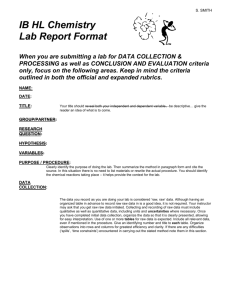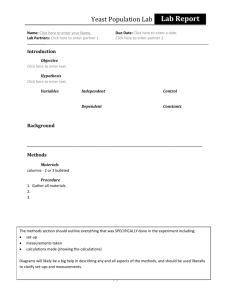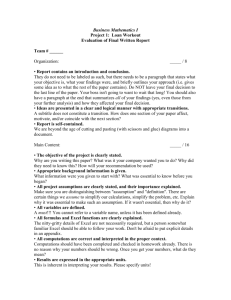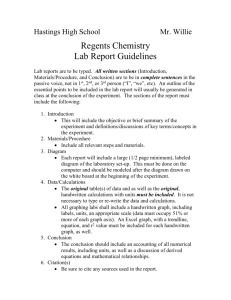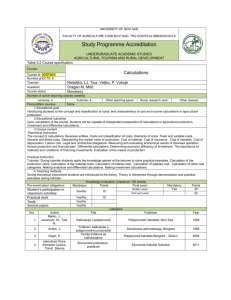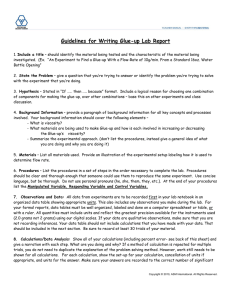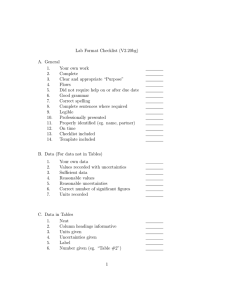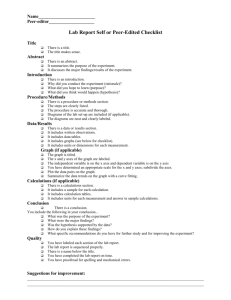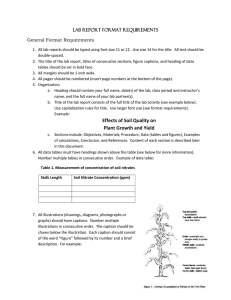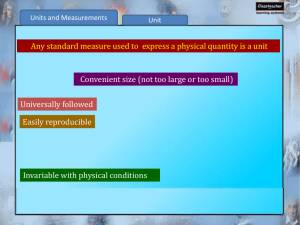Guide in Writing the Laboratory Report
advertisement
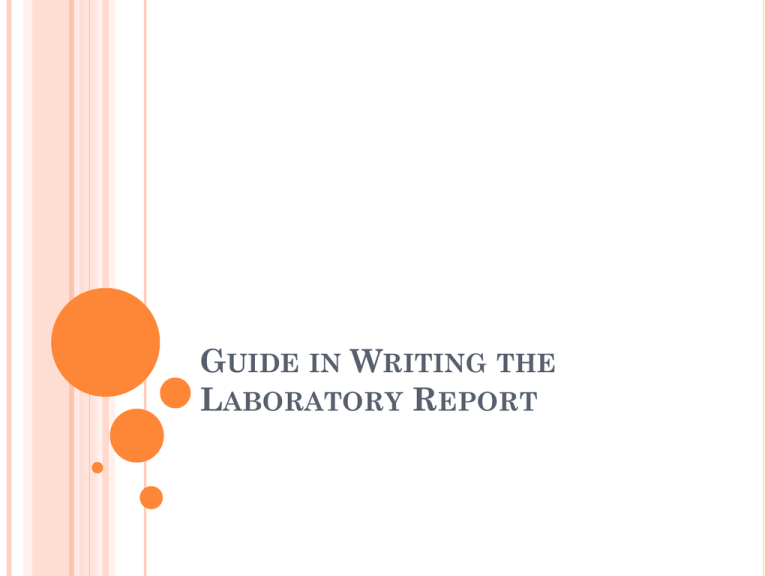
GUIDE IN WRITING THE LABORATORY REPORT PRESENTATION The Laboratory Report should have the following content: 1. Title 2. Objectives 3. Experimental Method 4. Data and Calculation 5. Results and Discussion 6. Conclusion 7. References PRESENTATION Informal Laboratory Report: Long bond paper; Handwritten; One output per group Formal Long Laboratory Report: Bong Paper; Individual Typewritten following the IEEE Format: http://paginas.fe.up.pt/~jca/wrsc/templates/IEEEConference-A4-format.pdf TITLE Use the title of the activity. For our purposes, the title will be used to distinguish one lab report from another. Use the creative title (bigger font) in the activity sheet. PURPOSE/ OBJECTIVE This is the part where you formulate the objective of the activity. Identify the concept or skill highlighted by this activity. Ask yourself, "Why did we do this activity? What was I suppose to learn or practice?" Sometimes the purpose can be stated in one sentence. Other times it may be necessary to add some extra information to narrow the scope of the activity. Make sure that the objective is specific and direct to the point. METHODOLOGY/ PROCEDURE The order of events is conveyed by the sentence order in the description. Remember that your audience should be able to repeat your procedure if they wish to do so. Write your description of what was done so that the reader can visualize the set-up. Include reference to any equipment that you used (e.g., Use a digital balance to get the mass of the sample) A diagram or picture of the apparatus may be helpful but should not replace a good verbal description. All the materials must be stated and included in the methodology. A drawing and sketch of the set-up may be included. Be very specific in your instructions. Emotions (e.g., It was difficult, or I had fun) are not necessary and detract from the purpose of this section. DATA AND CALCULATION This section should include only those things that you saw, heard, touched, or smelled. Taste is out since we never taste anything in a science lab. This includes both quantitative (numerical) and qualitative (sensual, not emotional) observations. Quantitative observations are best presented in data tables. Qualitative observations may be organized in table form or paragraph form. DATA AND CALCULATION Units are necessary for any measurement. Show all calculations, especially the derivation of any quantity or formula. If there is a theoretical or accepted value compare your results. You can compare by finding the percent error. REMEMBER ALL CALCULATIONS MUST BE SHOWN. RESULTS AND DISCUSSION Step 1: Write a sentence or two stating whether or not the results from the lab procedure fully support your objective; do not support the objective; or support it but with certain exceptions. RESULTS AND DISCUSSION Step 2: In a paragraph, identify specific data from the experiment that led you to either support or reject your objective. Refer to the visual representations of your data (graphs, tables, etc.) as evidence to back up your judgment about the objective. RESULTS AND DISCUSSION Step 3: In a paragraph, use your understanding of scientific concepts to explain why the results did or did not support your objective. Discuss the results of the experiment using information from Data and Calculations. Even if the data is inconsistent it should still be discussed explaining why the outcome is different. Use in-text citation. Note citations used and include in the Reference section of the report. RESULTS AND DISCUSSION Step 4: Discuss other pertinent items, such as: problems that occurred, or sources of uncertainties in the lab procedure that may account for any unexpected results; how the findings compare with theoretical or accepted values and an explanation for any differences. RESULTS AND DISCUSSION Remember to DISCUSS THE EXPERIMENT. Discussion must be based on your data and calculations and NOT on what you find in the internet and other references. Use the references to support your findings or explain uncertainties. CONCLUSION This is section discusses how the purpose of the activity relates to the analysis of your data. In other words, this section answers the question, “What did you learn?” Stick to the facts, do not comment on whether or not you enjoyed the activity. Be specific in your statements. If the results of the activity were not satisfactory, suggest how the activity could be improved to give better data. Did the activity raise questions that cannot be answered by the data collected? This is the place to mention them. Remember, conclusions are connections that are not obvious on the surface. CONCLUSION MUST ADDRESS YOUR OBJECTIVE REFERENCES This is the section where you cite the sources that you used in the report. Use the APA format to cite your references. http://old.citationmachine.net/index2.php?r eqstyleid=0&stylebox=2

